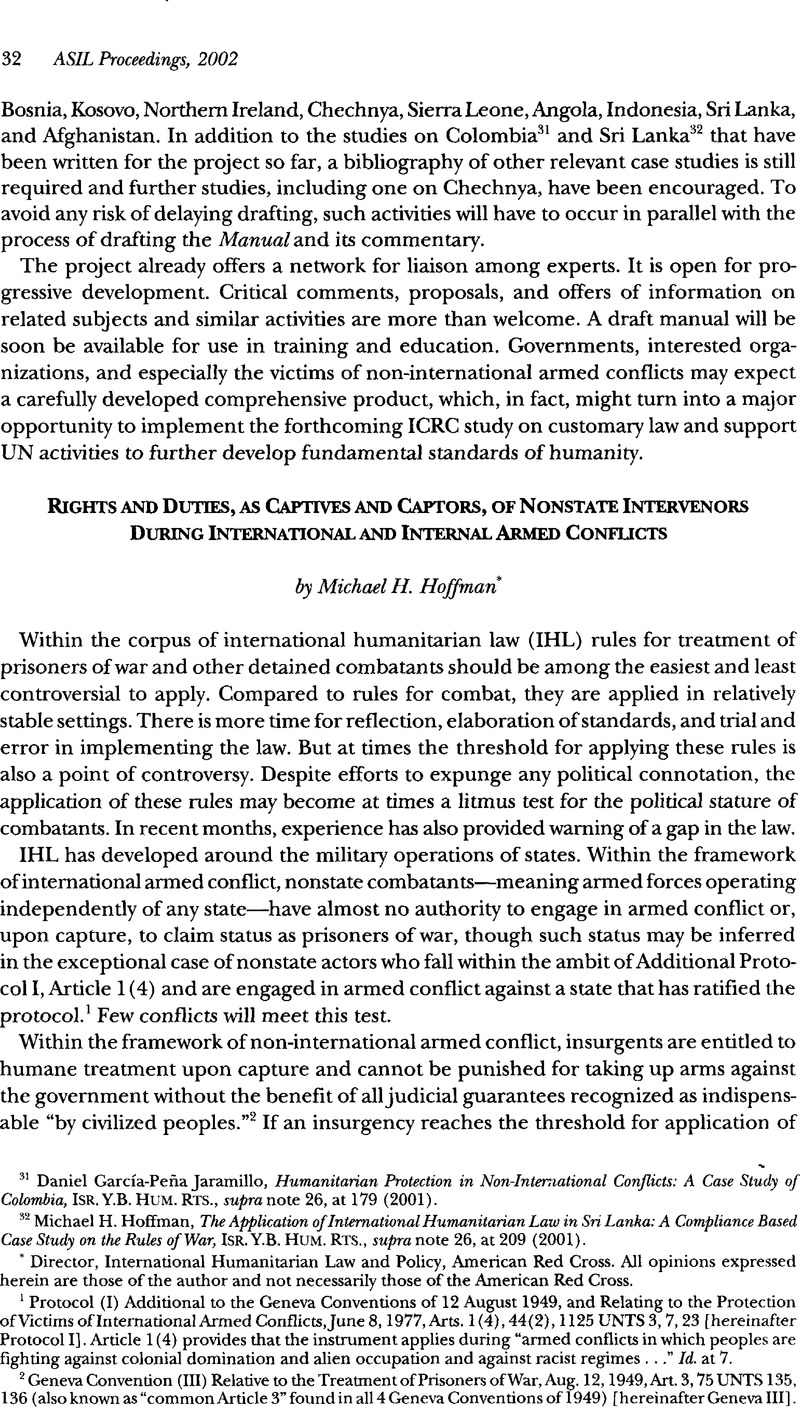No CrossRef data available.
Published online by Cambridge University Press: 28 February 2017

1 Protocol (I) Additional to the Geneva Conventions of 12 August 1949, and Relating to the Protection of Victims of International Armed Conflicts June 8, 1977, Arts. 1 (4), 44(2), 1125 UNTS 3, 7, 23 [hereinafter Protocol I]. Article 1 (4) provides that the instrument applies during “armed conflicts in which peoples are fighting against colonial domination and alien occupation and against racist regimes . ..” Id. at 7.
2 Geneva Convention (III) Relative to the Treatment of Prisoners of War, Aug. 12, 1949, Art. 3,75 UNTS 135, 136 (also known as “common Article 3” found in all 4 Geneva Conventions of 1949) [hereinafter Geneva Iii].
3 Protocol (II) Additional to the Geneva Conventions of 12 August 1949, and Relating to the Protection of Victims of Non-International Armed Conflicts, June 8, 1977, Arts. 5, 6, 1125 UNTS 609, 612-14 [hereinafter Protocol Ii].
4 Protocol I, Art. 1 (3), 1125 UNTS at 7; see also Jean S. Pictet, Commentary: Geneva Convention Relative to the Treatment of Prisoners of War 3-38 (1960); Commentary on the Additional Protocols of 8JUNE1977 to the Geneva Conventions of 12 August 1949 25, 1345 (Sandoz et. al. eds., 1987).
5 “The application of the preceding provisions shall not affect the legal status of the Parties to the conflict.” Geneva III, Art. 3, 75 UNTS at 138.
1. Nothing in this Protocol shall be invoked for the purpose of affecting the sovereignty of a State or the responsibility of the government, by all legitimate means, to maintain or re-establish law and order in the State or to defend the national unity and territorial integrity of the state. 2. Nothing in this Protocol shall be invoked as a justification for intervening, directly or indirectly, for any reason whatever, in the armed conflict or in the internal or external affairs of the High Contracting Party in the territory of which that conflict occurs.
Protocol II, Art. 3, 1125 UNTS at 611-12.
6 Protocol II, Art. 6(5), 1125 UNTS at 614.
7 Pietro Verri, Dictionary of the International Law of Armed Conflict 35 (1992).
8 “The application of the Conventions and of this Protocol, as well as the conclusion of the agreements provided for therein, shall not affect the legal status of the Parties to the conflict.” Protocol I, Art 4, 1125 UNTS at 8.
9 The Declaration Respecting Maritime Law of 1856 banned privateering at sea, which was the last widespread form of private warfare. See the Laws of Armed Conflicts 787 (Dietrich Schindler & Jiri Toman eds., 1988).
10 E.g., “Article 9. No one shall be subjected to arbitrary arrest, detention or exile.” Universal Declaration of Human Rights, Unga Res. 217 A(III), UN Doc. A/810 (1948).
11 For exceptions, consider, for example, the requirement that “[p]risoners of war shall be released and repatriated without delay after the cessation of active hostilities.” Geneva III, Art. 118, 75 UNTS at 224. A cessation of active hostilities is more easily determined when captives belong to the armed forces of a state that has ended belligerent operations and will not tolerate private, independent acts of belligerency by repatriated members from its ranks. A related question arises in relation to internal armed conflicts. Consider Protocol II, Art. 6(5), 1125 UNTS at 614. at the end of hostilities, the authorities mayor may not be inclined to “grant the broadest possible amnesty” and immediately repatriate a group of foreign captives who have intervened in their territory, without any state sanction, and waged private warfare.
12 “Details emerge on death of Navy Seal.... Soon after a U.S. helicopter was hit by a rocket-propelled grenade Monday, a Navy Seal fell from the Chinook and was dragged away by three Ai Qaeda fighters and executed.” Details Emerge on Death of Navy Seal, CNN, Mar. 6, 2002, at <http://www.cnn.com/2002/WORLD/asiapcf/central/03/05/afghan.helicopter.horror>.
13 E.g., “The decision of the Military Court in the present case is a clear example of the application of the rule that the provisions of the laws and customs of war are addressed not only to combatants and to members of state and other public authorities, but to anybody who is in a position to assist in their violation.” United Nations War Crimes Commission, The Zyklon B Case: Notes on the Case, 1 Law Reports of Trials of War Criminals 93-102, 103 (1946).